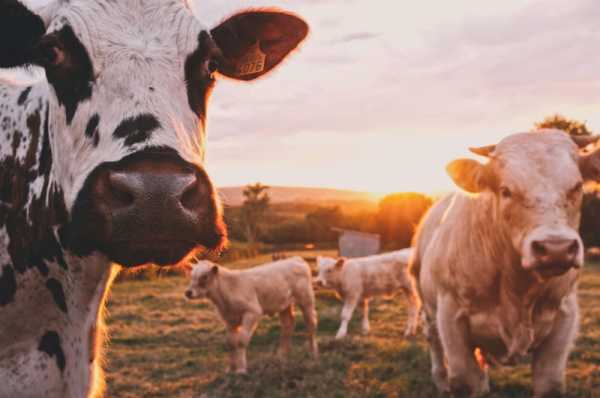
Factory farm gas is a crucial PR tool used by the industrial livestock industry to argue that livestock numbers do not need to be reduced because this tech fix makes the industry green (Photo: Stijn te Strake)
EU proposals to expand ‘green gas’ or ‘biomethane’, which the European Parliament will vote on in its revision of the Renewable Energy Directive next week (13 September), could expand the industry indiscriminately and have damaging effects.
Biomethane could supplant better alternatives, including dietary change, food waste prevention, afforestation, plant-based protein production and renewable electricity.
The production of biomethane begins when organic materials (‘feedstocks’) such as bioenergy crops, food waste and manure are broken down by microorganisms through anaerobic digestion.
This produces biogas and nutrient-rich digestate fertiliser. Biogas can be further refined into biomethane, which can then be injected into the gas grid for heating or used as biofuel for transport.
There are many problems with biomethane.
For instance, the fossil gas industry frequently champions biomethane and hydrogen as a substitute for electrification, so gas infrastructure can keep supplying fossil gas in the meantime. But wind and solar produce significantly lower emissions and are cheaper.
Moreover, promising research shows that electrification of even heavy goods vehicles and tractors is possible.
The digestate fertiliser produced from anaerobic digestion has high nitrogen content, so risks polluting water and degrading soil health. We should ensure that anaerobic digestion plants build in a post-composting step, as required in Italy.
Using bioenergy crops, like maize or grass to feed digestors is a poor use of land in terms of energy generation, emissions mitigation and food security. Solar PV currently generates 12–18 times more energy per hectare than maize or grass grown for anaerobic digestion.
Planting trees saves 11.5 times more emissions per hectare than growing grass as a bioenergy crop.
Additionally, land could be better used to grow food for human consumption, particularly as the war in Ukraine threatens food security. Moreover, maize is terrible for soil — in the UK, 75 percent of sites growing maize show high or severe levels of soil erosion.
Prevention is better than cure
While food waste and manure are promoted as sustainable alternatives to feed digestors, here, too, there are significant problems. Preventing food waste saves approximately nine times more emissions than sending it to an anaerobic digestor, per average tonne of food waste — and 40 times more when spared grassland is instead afforested.
Sending food waste to animal feed saves nearly three times the emissions as sending it to anaerobic digestion — and spares additional cropland for food production.
The European Environmental Bureau has estimated that halving EU food waste by 2030 would save 4.7 million hectares of agricultural land.
While sending unavoidable food waste to anaerobic digestion or composting instead of incineration or landfill is preferable, our priority should always be prevention.
We need to design policy ensuring digestors do not lower waste disposal costs and inadvertently disincentivise food waste prevention.
At best, digestors only mitigate some emissions from manure — but this is only a fraction of industrial livestock’s emissions, which originate from enteric fermentation (burps and farts), animal feed and pressures for land use change like deforestation. At worst, digestors actively help perpetuate and grow this polluting industry.
PR tool
Factory farm gas is a crucial PR tool used by the industrial livestock industry to argue that livestock numbers do not need to be reduced because this tech fix makes the industry green. Badly-designed incentives and subsidies for digestors can actually facilitate the expansion of factory farming.
Take, for instance, Northern Ireland’s Going for Growth strategy to expand pig and poultry production. By highly subsidising digestors, the government was able to provide an outlet for all the extra animal waste, lower waste disposal costs, help factory farms gain planning permission, and bypass nitrate regulations.
Instead of paying for their chicken litter to be disposed of, at up to £90 [€150] per tonne, producers were paid for their wastes by the digestors. By 2020, Northern Ireland produced 41 percent more pigs and 30 percent more chickens than in 2013, mainly in intensive farming facilities.
Biomethane from digestors can still be scaled up to play an important role in the EU’s energy mix, as long as it stays within its sustainable niche — as laid out in Feedback’s Green Gas Without the Hot Air report.
Biomethane can be valuably produced from unavoidable wastes since some sectors will take time to electrify. However, better alternatives to anaerobic digestion should be prioritised.
This means a just transition to lower meat diets, halving food waste by 2030, electrification of heat and transport powered by wind and solar, and reducing energy demand through insulation and public transport. Incentives for biomethane production should be designed to support these objectives, not replace or undermine them.
Specifically, in the European Parliament vote on 13 September policymakers should reconsider the 35 billion cubic meters (bcm) target for biomethane, which is excessive and unrealistic, set strict sustainability criteria to ensure against the use of bioenergy crops as feedstocks for digestors, and ensure that waste prevention and industrial livestock reduction are prioritised.
Source: euobserver.com